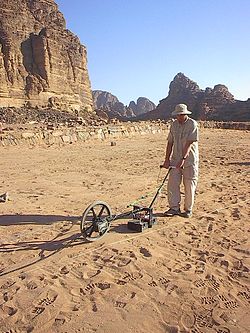All Categories
Featured
Table of Contents
Services Geophysical - Utility Survey Corp. in Mount Nasura Australia 2020
Time piece from 23 to 25ns. This last piece is now practically all blank, but a few of the walls are still showing strongly.
How deep are these slices? Sadly, the software I have access to makes estimating the depth a little tricky. If, nevertheless, the top three pieces represent the ploughsoil, which is most likely about 30cm think, I would guess that each piece has to do with 10cm and we are only getting down about 80cm in total.

Thankfully for us, most of the sites we have an interest in lie simply listed below the plough zone, so it'll do! How does this compare to the other methods? Contrast of the Earth Resistance data (top left), the magnetometry (bottom left), the 1517ns time slice (leading right) and the 1921ns time slice (bottom left).
Archaeology Arch 1 - Geophysical Survey Flashcards in Myaree Oz 2022
Magnetometry, as gone over above, is a passive strategy measuring local variations in magnetism against a localised absolutely no value. Magnetic vulnerability survey is an active method: it is a step of how magnetic a sample of sediment might be in the presence of a magnetic field. Just how much soil is evaluated depends on the diameter of the test coil: it can be extremely small or it can be relatively big.
The sensing unit in this case is extremely little and samples a tiny sample of soil. The Bartington magnetic vulnerability meter with a big "field coil" in use at Verulamium throughout the course in 2013. Leading soil will be magnetically enhanced compared to subsoils simply due to natural oxidation and decrease.
By determining magnetic vulnerability at a relatively coarse scale, we can find areas of human occupation and middens. We do not have access to a reliable mag sus meter, but Jarrod Burks (who assisted teach at the course in 2013) has some exceptional examples. One of which is the Wildcat site in Ohio.
Geophysical Methods in Glendalough WA 2022
These villages are frequently laid out around a main open location or plaza, such as this reconstructed example at Sunwatch, Dayton, Ohio. The magnetic susceptibility survey helped, nevertheless, specify the primary location of occupation and midden which surrounded the more open location.
Jarrod Burks' magnetic susceptibility survey results from the Wildcat site, Ohio. Red is high, blue is low. The technique is for that reason of excellent usage in specifying locations of basic occupation instead of determining specific functions.
Geophysical surveying is an applied branch of geophysics, which utilizes seismic, gravitational, magnetic, electrical and electro-magnetic physical methodologies at the Earth's surface to measure the physical properties of the subsurface - Uses For Geophysical Data in Shelley Oz 2021. Geophysical surveying methods generally determine these geophysical properties along with anomalies in order to evaluate different subsurface conditions such as the existence of groundwater, bedrock, minerals, oil and gas, geothermal resources, voids and cavities, and a lot more.
Latest Posts
Geophysical Survey in Jandakot Australia 2020
Geophysics Definition & Meaning in Roleystone Oz 2021
Geophysical Survey - Explore The Seafloor in Kinross WA 2021